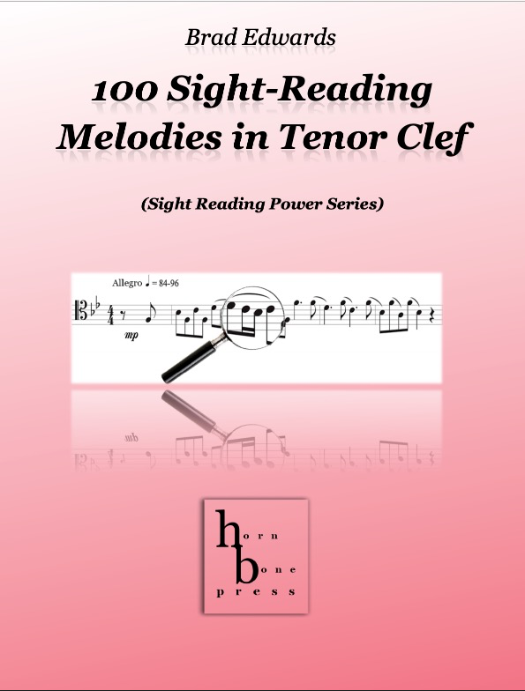Brad Edwards
 100 Sight-Reading Melodies in Tenor Clef:
100 Sight-Reading Melodies in Tenor Clef:
Trombone
No place, , United States
Publisher: Hornbone press
Date of Publication: 2020
URL: http://www.hornbonepress.com
Etude/method book. 106 pages.
Primary Genre: Study Material - etude
Secondary Genre: Study Material - method
 100 Sight-Reading Melodies in Tenor Clef:
100 Sight-Reading Melodies in Tenor Clef: Trombone
No place, , United States
Publisher: Hornbone press
Date of Publication: 2020
URL: http://www.hornbonepress.com
Etude/method book. 106 pages.
Primary Genre: Study Material - etude
Secondary Genre: Study Material - method
100 Sight-Reading Melodies in Tenor Clef is a substantive addition to our trombone pedagogy library. Brad Edwards designs this publication as a supplement to his earlier publication Introductory Studies in Tenor and Alto Clef. Like the Introductory Studies, this book proceeds from simple to more difficult. In the beginning the keys are easier and the melodic patterns more predictable. However, instead of etudes to be practiced, the author instructs the student to read these melodies several times and then move on. Edwards begins the book with important instructions for sight-reading. He proposes a three-step “pre-play” process. First study the melody for ten seconds to capture the important basic information: key, meter, tempo, dynamics. Answer those questions and then look again and observe accidentals, trickier rhythms, and the highest and lowest notes. Finally, read the music for ten more seconds and then try to play by memory as much of the melody as you can. Making these active learning suggestions habitual will improve a student’s reading skills in any clef. The first division of melodies is introductory. Prior to each melody there is a brief exercise to introduce the key and melodic contour of the melody that follows. These melodies are simple and scalar. Two measures of bass clef melody are followed by the same melody in tenor clef. Soon the melodies are entirely in tenor clef. The next divisions, beginning at the 17th melody, successively introduce melodies with triads, fifths and octaves, and octave arpeggios. At this point the melodies no longer have an introductory exercise. The 38th melody introduces a section entitled “Pivot Points.” Here the melodies and rhythms are more complex and feature ever widening intervals that return to a common pitch. Until this point, Edwards has only composed in simpler keys, but beginning with the 45th melody the keys become more difficult—up to four sharps and six flats. Once again, he begins with scalar melodies and incrementally introduces arpeggios, wider intervals and finally pivot points. Another important progression occurs in melody 69 with the introduction of minor keys and more accidentals. In this section the melodies progress once again from simpler to more complex. Finally, at the 89th melody, Edwards composes melodies that alternate between bass and tenor clefs. 100 Sight-Reading Melodies is only published in a pdf version and is optimized for electronic viewing. There is one melody per page so no scrolling will be necessary. As you can gather from the narrative above, this pedagogical work is crafted with careful thought. Its incremental progress will allow students to succeed immediately and develop their tenor clef reading thoroughly. It will prove extremely helpful to the advanced high school or collegiate trombonist.
Reviewer: Paul Overly
Review Published June 24, 2023
Review Published June 24, 2023